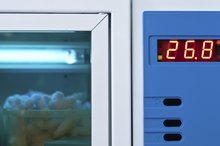What Is the Difference Between Good Bacteria & Bad Bacteria?
The human body encounters both good and bad bacteria daily. To microorganisms, the human body represents an attractive environment and source of nutrients. Bacteria that we call "good" helps us digest our food and protects us from bad bacteria that can make us sick or even kill us. Without good bacteria we would die, according to the US Department of Energy. Good bacteria live in our digestive system, on our skin and in our mouth. Bad bacteria may get into our body by contaminated food, wounds or environmental pollution.
If you are experiencing serious medical symptoms, seek emergency treatment immediately.
Identification
Bacteria are single-celled living things that are neither plants nor animals and have their own biologic classification called prokaryotes. An outer cell wall and plasma membrane surrounds their one cell but they have no internal organelles bound by membranes, according to Arthur Vander, James Sherman and Dorothy Luciano in “Human Physiology.”
Thousands of species of bacteria are found in the soil, water and on dust particles in the air. Some bacteria can damage tissues or release toxins that enter the blood and disrupt physiological functions. Other bacteria can perform useful functions for the human body.
Good Bacteria
Can Probiotics Be Harmful to Cancer Patients?
Learn More
Certain bacteria are safe in food and actually produce its desired taste and texture. For instance, bacteria are commonly used in dairy products such as yogurt and fermented milk. Fermented milk products help people with lactose intolerance digest dairy products that otherwise would cause cramps and diarrhea. The different flavor of fermented dairy products is due to the bacteria used to make them.
Some bacteria, such as Lactobacillus rhamnosus, have been shown to enhance the immune system by regulation and stimulation, according to Philip Calder, Catherine Field and Harsharnjit Gill in “Nutrition and Immune Function.” They also may form a barrier to help protect us from bad bacteria by altering the pH or acidity level or by releasing toxins that harm the bad bacteria.
Bad Bacteria
Pathogenic or bad bacteria produce results ranging in severity from food poisoning or toothache to death, according to the Virtual Museum of Bacteria. Some bacteria such as salmonella may cause a brief bout with stomachache or diarrhea and may in some cases lead to death. Others cause diseases such as anthrax that are so severe they have been used by bioterrorists.
Food-borne Illnesses
How Does UV Light Kill Bacteria?
Learn More
The Food and Drug Administration, monitors the U.S. food supply and sets safety standards. The leading food safety concern, according to the FDA, is food-borne illness. The Centers for Disease Control and Prevention, estimates that 76 million people experience food-borne illness each year in the U.S., as reported by Eleanor Whitney and Sharon Rolfes in “Understanding Nutrition.”
The very old, very young, pregnant women, sick or malnourished people and people with weakened immune systems prove most vulnerable to food-borne illness.
Significance
Most bacteria are harmless to humans and some are beneficial. Mutually beneficial or symbiotic bacteria not only help you with digestion but also help produce vitamins and protect you against bad bacteria. When you take antibiotics for illness, both bad and good bacteria are killed. Your cure is not complete until your friendly bacteria are replaced.
Other benefits of bacteria include decomposing dead plants and animals, producing oxygen, controlling plant pests and making nitrogen from the air available as food for plants that produce essential nutrients for humans. In many ways, bacteria help to sustain life for humans.
Related Articles
Writer Bio
Norma DeVault, a registered dietitian, has been writing health-related articles since 2006. Her articles have appeared in the "Journal of the American Dietetic Association.” She holds a Doctor of Philosophy in human environmental sciences from Oklahoma State University and a Master of Business Administration from the University of Tulsa.









